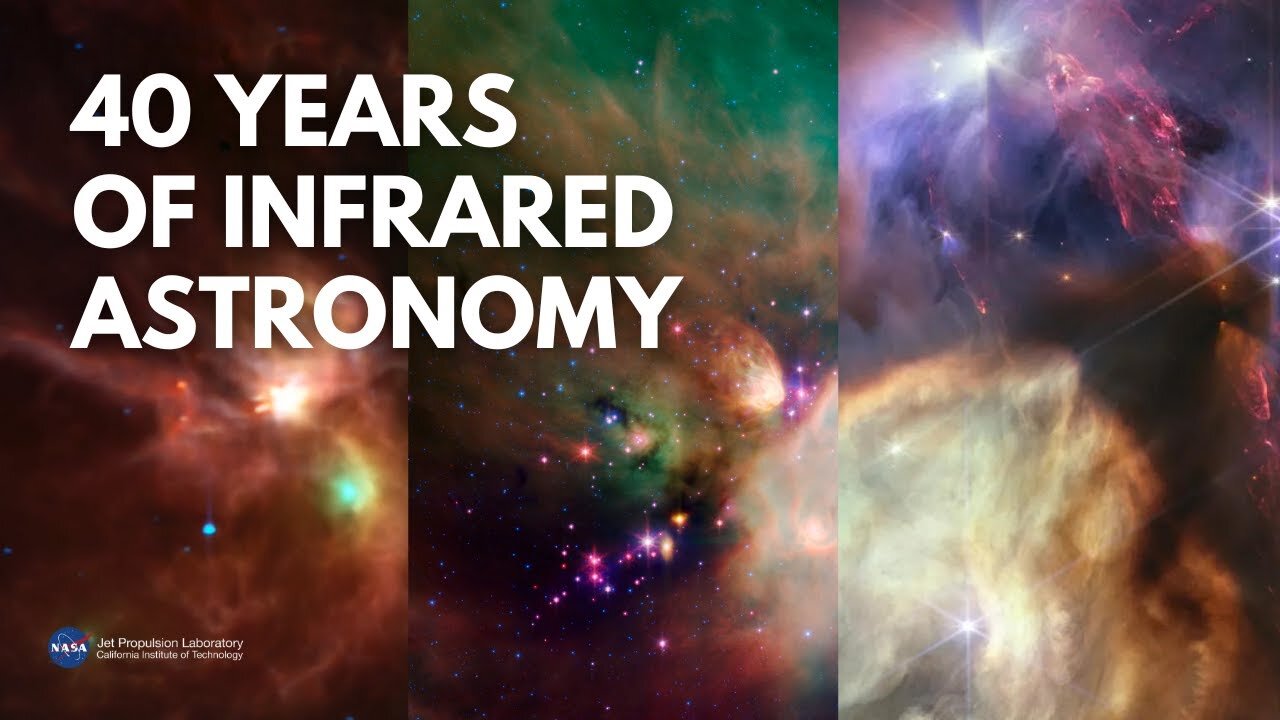Premium Only Content

NASA Telescopes Reveal an Invisible Infrared Universe
For 40 years, NASA has expanded our view of the universe with space telescopes that detect infrared light, which is invisible to the human eye. Observing the infrared realm helps us study the origins of planets, stars, galaxies, and even the universe itself.
NASA’s James Webb Space Telescope is the agency’s latest infrared space telescope, adding new insights to targets first discovered and studied by infrared missions that came before it.
Infrared space telescope missions have built upon one another to reveal stars, galaxies, and all manner of cosmic objects with ever-increasing clarity. Here you will see images from the pioneering Infrared Astronomical Satellite (IRAS), launched in 1983, the Spitzer Space Telescope, launched in 2003, and the James Webb Space Telescope, which launched in 2021 and is sending back extremely detailed images today.
For more information about Webb, visit: https://www.nasa.gov/webb
For more information about Spitzer, visit: https://www.nasa.gov/spitzer
For more information about IRAS, visit: https://www.jpl.nasa.gov/missions/inf...
Credits: IRAS images: NASA/Netherlands Agency for Aerospace Programmes/UK Science and Engineering Research Council/JPL-Caltech; Spitzer images: NASA/JPL-Caltech/IPAC; Webb images: NASA/ESA/CSA/STScI
For 40 years, NASA has expanded our view of the universe with space telescopes that detect infrared light, which is invisible to the human eye. Observing the infrared realm helps us study the origins of planets, stars, galaxies, and even the universe itself.
NASA’s James Webb Space Telescope is the agency’s latest infrared space telescope, adding new insights to targets first discovered and studied by infrared missions that came before it.
Infrared space telescope missions have built upon one another to reveal stars, galaxies, and all manner of cosmic objects with ever-increasing clarity. Here you will see images from the pioneering Infrared Astronomical Satellite (IRAS), launched in 1983, the Spitzer Space Telescope, launched in 2003, and the James Webb Space Telescope, which launched in 2021 and is sending back extremely detailed images today.
For more information about Webb, visit: https://www.nasa.gov/webb
For more information about Spitzer, visit: https://www.nasa.gov/spitzer
For more information about IRAS, visit: https://www.jpl.nasa.gov/missions/inf...
Credits: IRAS images: NASA/Netherlands Agency for Aerospace Programmes/UK Science and Engineering Research Council/JPL-Caltech; Spitzer images: NASA/JPL-Caltech/IPAC; Webb images: NASA/ESA/CSA/STScI
For 40 years, NASA has expanded our view of the universe with space telescopes that detect infrared light, which is invisible to the human eye. Observing the infrared realm helps us study the origins of planets, stars, galaxies, and even the universe itself.
NASA’s James Webb Space Telescope is the agency’s latest infrared space telescope, adding new insights to targets first discovered and studied by infrared missions that came before it.
Infrared space telescope missions have built upon one another to reveal stars, galaxies, and all manner of cosmic objects with ever-increasing clarity. Here you will see images from the pioneering Infrared Astronomical Satellite (IRAS), launched in 1983, the Spitzer Space Telescope, launched in 2003, and the James Webb Space Telescope, which launched in 2021 and is sending back extremely detailed images today.
For more information about Webb, visit: https://www.nasa.gov/webb
For more information about Spitzer, visit: https://www.nasa.gov/spitzer
For more information about IRAS, visit: https://www.jpl.nasa.gov/missions/inf...
Credits: IRAS images: NASA/Netherlands Agency for Aerospace Programmes/UK Science and Engineering Research Council/JPL-Caltech; Spitzer images: NASA/JPL-Caltech/IPAC; Webb images: NASA/ESA/CSA/STScI
For 40 years, NASA has expanded our view of the universe with space telescopes that detect infrared light, which is invisible to the human eye. Observing the infrared realm helps us study the origins of planets, stars, galaxies, and even the universe itself.
NASA’s James Webb Space Telescope is the agency’s latest infrared space telescope, adding new insights to targets first discovered and studied by infrared missions that came before it.
Infrared space telescope missions have built upon one another to reveal stars, galaxies, and all manner of cosmic objects with ever-increasing clarity. Here you will see images from the pioneering Infrared Astronomical Satellite (IRAS), launched in 1983, the Spitzer Space Telescope, launched in 2003, and the James Webb Space Telescope, which launched in 2021 and is sending back extremely detailed images today.
For more information about Webb, visit: https://www.nasa.gov/webb
For more information about Spitzer, visit: https://www.nasa.gov/spitzer
For more information about IRAS, visit: https://www.jpl.nasa.gov/missions/inf...
Credits: IRAS images: NASA/Netherlands Agency for Aerospace Programmes/UK Science and Engineering Research Council/JPL-Caltech; Spitzer images: NASA/JPL-Caltech/IPAC; Webb images: NASA/ESA/CSA/STScI
For 40 years, NASA has expanded our view of the universe with space telescopes that detect infrared light, which is invisible to the human eye. Observing the infrared realm helps us study the origins of planets, stars, galaxies, and even the universe itself.
NASA’s James Webb Space Telescope is the agency’s latest infrared space telescope, adding new insights to targets first discovered and studied by infrared missions that came before it.
Infrared space telescope missions have built upon one another to reveal stars, galaxies, and all manner of cosmic objects with ever-increasing clarity. Here you will see images from the pioneering Infrared Astronomical Satellite (IRAS), launched in 1983, the Spitzer Space Telescope, launched in 2003, and the James Webb Space Telescope, which launched in 2021 and is sending back extremely detailed images today.
For more information about Webb, visit: https://www.nasa.gov/webb
For more information about Spitzer, visit: https://www.nasa.gov/spitzer
For more information about IRAS, visit: https://www.jpl.nasa.gov/missions/inf...
Credits: IRAS images: NASA/Netherlands Agency for Aerospace Programmes/UK Science and Engineering Research Council/JPL-Caltech; Spitzer images: NASA/JPL-Caltech/IPAC; Webb images: NASA/ESA/CSA/STScI
For 40 years, NASA has expanded our view of the universe with space telescopes that detect infrared light, which is invisible to the human eye. Observing the infrared realm helps us study the origins of planets, stars, galaxies, and even the universe itself.
NASA’s James Webb Space Telescope is the agency’s latest infrared space telescope, adding new insights to targets first discovered and studied by infrared missions that came before it.
Infrared space telescope missions have built upon one another to reveal stars, galaxies, and all manner of cosmic objects with ever-increasing clarity. Here you will see images from the pioneering Infrared Astronomical Satellite (IRAS), launched in 1983, the Spitzer Space Telescope, launched in 2003, and the James Webb Space Telescope, which launched in 2021 and is sending back extremely detailed images today.
For more information about Webb, visit: https://www.nasa.gov/webb
For more information about Spitzer, visit: https://www.nasa.gov/spitzer
For more information about IRAS, visit: https://www.jpl.nasa.gov/missions/inf...
Credits: IRAS images: NASA/Netherlands Agency for Aerospace Programmes/UK Science and Engineering Research Council/JPL-Caltech; Spitzer images: NASA/JPL-Caltech/IPAC; Webb images: NASA/ESA/CSA/STScI
For 40 years, NASA has expanded our view of the universe with space telescopes that detect infrared light, which is invisible to the human eye. Observing the infrared realm helps us study the origins of planets, stars, galaxies, and even the universe itself.
NASA’s James Webb Space Telescope is the agency’s latest infrared space telescope, adding new insights to targets first discovered and studied by infrared missions that came before it.
Infrared space telescope missions have built upon one another to reveal stars, galaxies, and all manner of cosmic objects with ever-increasing clarity. Here you will see images from the pioneering Infrared Astronomical Satellite (IRAS), launched in 1983, the Spitzer Space Telescope, launched in 2003, and the James Webb Space Telescope, which launched in 2021 and is sending back extremely detailed images today.
For more information about Webb, visit: https://www.nasa.gov/webb
For more information about Spitzer, visit: https://www.nasa.gov/spitzer
For more information about IRAS, visit: https://www.jpl.nasa.gov/missions/inf...
Credits: IRAS images: NASA/Netherlands Agency for Aerospace Programmes/UK Science and Engineering Research Council/JPL-Caltech; Spitzer images: NASA/JPL-Caltech/IPAC; Webb images: NASA/ESA/CSA/STScI
For 40 years, NASA has expanded our view of the universe with space telescopes that detect infrared light, which is invisible to the human eye. Observing the infrared realm helps us study the origins of planets, stars, galaxies, and even the universe itself.
NASA’s James Webb Space Telescope is the agency’s latest infrared space telescope, adding new insights to targets first discovered and studied by infrared missions that came before it.
Infrared space telescope missions have built upon one another to reveal stars, galaxies, and all manner of cosmic objects with ever-increasing clarity. Here you will see images from the pioneering Infrared Astronomical Satellite (IRAS), launched in 1983, the Spitzer Space Telescope, launched in 2003, and the James Webb Space Telescope, which launched in 2021 and is sending back extremely detailed images today.
For more information about Webb, visit: https://www.nasa.gov/webb
For more information about Spitzer, visit: https://www.nasa.gov/spitzer
For more information about IRAS, visit: https://www.jpl.nasa.gov/missions/inf...
Credits: IRAS images: NASA/Netherlands Agency for Aerospace Programmes/UK Science and Engineering Research Council/JPL-Caltech; Spitzer images: NASA/JPL-Caltech/IPAC; Webb images: NASA/ESA/CSA/STScI
For 40 years, NASA has expanded our view of the universe with space telescopes that detect infrared light, which is invisible to the human eye. Observing the infrared realm helps us study the origins of planets, stars, galaxies, and even the universe itself.
NASA’s James Webb Space Telescope is the agency’s latest infrared space telescope, adding new insights to targets first discovered and studied by infrared missions that came before it.
Infrared space telescope missions have built upon one another to reveal stars, galaxies, and all manner of cosmic objects with ever-increasing clarity. Here you will see images from the pioneering Infrared Astronomical Satellite (IRAS), launched in 1983, the Spitzer Space Telescope, launched in 2003, and the James Webb Space Telescope, which launched in 2021 and is sending back extremely detailed images today.
For more information about Webb, visit: https://www.nasa.gov/webb
For more information about Spitzer, visit: https://www.nasa.gov/spitzer
For more information about IRAS, visit: https://www.jpl.nasa.gov/missions/inf...
Credits: IRAS images: NASA/Netherlands Agency for Aerospace Programmes/UK Science and Engineering Research Council/JPL-Caltech; Spitzer images: NASA/JPL-Caltech/IPAC; Webb images: NASA/ESA/CSA/STScI
For 40 years, NASA has expanded our view of the universe with space telescopes that detect infrared light, which is invisible to the human eye. Observing the infrared realm helps us study the origins of planets, stars, galaxies, and even the universe itself.
NASA’s James Webb Space Telescope is the agency’s latest infrared space telescope, adding new insights to targets first discovered and studied by infrared missions that came before it.
Infrared space telescope missions have built upon one another to reveal stars, galaxies, and all manner of cosmic objects with ever-increasing clarity. Here you will see images from the pioneering Infrared Astronomical Satellite (IRAS), launched in 1983, the Spitzer Space Telescope, launched in 2003, and the James Webb Space Telescope, which launched in 2021 and is sending back extremely detailed images today.
For more information about Webb, visit: https://www.nasa.gov/webb
For more information about Spitzer, visit: https://www.nasa.gov/spitzer
For more information about IRAS, visit: https://www.jpl.nasa.gov/missions/inf...
Credits: IRAS images: NASA/Netherlands Agency for Aerospace Programmes/UK Science and Engineering Research Council/JPL-Caltech; Spitzer images: NASA/JPL-Caltech/IPAC; Webb images: NASA/ESA/CSA/STScI
For 40 years, NASA has expanded our view of the universe with space telescopes that detect infrared light, which is invisible to the human eye. Observing the infrared realm helps us study the origins of planets, stars, galaxies, and even the universe itself.
NASA’s James Webb Space Telescope is the agency’s latest infrared space telescope, adding new insights to targets first discovered and studied by infrared missions that came before it.
Infrared space telescope missions have built upon one another to reveal stars, galaxies, and all manner of cosmic objects with ever-increasing clarity. Here you will see images from the pioneering Infrared Astronomical Satellite (IRAS), launched in 1983, the Spitzer Space Telescope, launched in 2003, and the James Webb Space Telescope, which launched in 2021 and is sending back extremely detailed images today.
For more information about Webb, visit: https://www.nasa.gov/webb
For more information about Spitzer, visit: https://www.nasa.gov/spitzer
For more information about IRAS, visit: https://www.jpl.nasa.gov/missions/inf...
Credits: IRAS images: NASA/Netherlands Agency for Aerospace Programmes/UK Science and Engineering Research Council/JPL-Caltech; Spitzer images: NASA/JPL-Caltech/IPAC; Webb images: NASA/ESA/CSA/STScI
For 40 years, NASA has expanded our view of the universe with space telescopes that detect infrared light, which is invisible to the human eye. Observing the infrared realm helps us study the origins of planets, stars, galaxies, and even the universe itself.
NASA’s James Webb Space Telescope is the agency’s latest infrared space telescope, adding new insights to targets first discovered and studied by infrared missions that came before it.
Infrared space telescope missions have built upon one another to reveal stars, galaxies, and all manner of cosmic objects with ever-increasing clarity. Here you will see images from the pioneering Infrared Astronomical Satellite (IRAS), launched in 1983, the Spitzer Space Telescope, launched in 2003, and the James Webb Space Telescope, which launched in 2021 and is sending back extremely detailed images today.
For more information about Webb, visit: https://www.nasa.gov/webb
For more information about Spitzer, visit: https://www.nasa.gov/spitzer
For more information about IRAS, visit: https://www.jpl.nasa.gov/missions/inf...
Credits: IRAS images: NASA/Netherlands Agency for Aerospace Programmes/UK Science and Engineering Research Council/JPL-Caltech; Spitzer images: NASA/JPL-Caltech/IPAC; Webb images: NASA/ESA/CSA/STScI
For 40 years, NASA has expanded our view of the universe with space telescopes that detect infrared light, which is invisible to the human eye. Observing the infrared realm helps us study the origins of planets, stars, galaxies, and even the universe itself.
NASA’s James Webb Space Telescope is the agency’s latest infrared space telescope, adding new insights to targets first discovered and studied by infrared missions that came before it.
Infrared space telescope missions have built upon one another to reveal stars, galaxies, and all manner of cosmic objects with ever-increasing clarity. Here you will see images from the pioneering Infrared Astronomical Satellite (IRAS), launched in 1983, the Spitzer Space Telescope, launched in 2003, and the James Webb Space Telescope, which launched in 2021 and is sending back extremely detailed images today.
For more information about Webb, visit: https://www.nasa.gov/webb
For more information about Spitzer, visit: https://www.nasa.gov/spitzer
For more information about IRAS, visit: https://www.jpl.nasa.gov/missions/inf...
Credits: IRAS images: NASA/Netherlands Agency for Aerospace Programmes/UK Science and Engineering Research Council/JPL-Caltech; Spitzer images: NASA/JPL-Caltech/IPAC; Webb images: NASA/ESA/CSA/STScI
For 40 years, NASA has expanded our view of the universe with space telescopes that detect infrared light, which is invisible to the human eye. Observing the infrared realm helps us study the origins of planets, stars, galaxies, and even the universe itself.
NASA’s James Webb Space Telescope is the agency’s latest infrared space telescope, adding new insights to targets first discovered and studied by infrared missions that came before it.
Infrared space telescope missions have built upon one another to reveal stars, galaxies, and all manner of cosmic objects with ever-increasing clarity. Here you will see images from the pioneering Infrared Astronomical Satellite (IRAS), launched in 1983, the Spitzer Space Telescope, launched in 2003, and the James Webb Space Telescope, which launched in 2021 and is sending back extremely detailed images today.
For more information about Webb, visit: https://www.nasa.gov/webb
For more information about Spitzer, visit: https://www.nasa.gov/spitzer
For more information about IRAS, visit: https://www.jpl.nasa.gov/missions/inf...
Credits: IRAS images: NASA/Netherlands Agency for Aerospace Programmes/UK Science and Engineering Research Council/JPL-Caltech; Spitzer images: NASA/JPL-Caltech/IPAC; Webb images: NASA/ESA/CSA/STScI
For 40 years, NASA has expanded our view of the universe with space telescopes that detect infrared light, which is invisible to the human eye. Observing the infrared realm helps us study the origins of planets, stars, galaxies, and even the universe itself.
NASA’s James Webb Space Telescope is the agency’s latest infrared space telescope, adding new insights to targets first discovered and studied by infrared missions that came before it.
Infrared space telescope missions have built upon one another to reveal stars, galaxies, and all manner of cosmic objects with ever-increasing clarity. Here you will see images from the pioneering Infrared Astronomical Satellite (IRAS), launched in 1983, the Spitzer Space Telescope, launched in 2003, and the James Webb Space Telescope, which launched in 2021 and is sending back extremely detailed images today.
For more information about Webb, visit: https://www.nasa.gov/webb
For more information about Spitzer, visit: https://www.nasa.gov/spitzer
For more information about IRAS, visit: https://www.jpl.nasa.gov/missions/inf...
Credits: IRAS images: NASA/Netherlands Agency for Aerospace Programmes/UK Science and Engineering Research Council/JPL-Caltech; Spitzer images: NASA/JPL-Caltech/IPAC; Webb images: NASA/ESA/CSA/STScI
For 40 years, NASA has expanded our view of the universe with space telescopes that detect infrared light, which is invisible to the human eye. Observing the infrared realm helps us study the origins of planets, stars, galaxies, and even the universe itself.
NASA’s James Webb Space Telescope is the agency’s latest infrared space telescope, adding new insights to targets first discovered and studied by infrared missions that came before it.
Infrared space telescope missions have built upon one another to reveal stars, galaxies, and all manner of cosmic objects with ever-increasing clarity. Here you will see images from the pioneering Infrared Astronomical Satellite (IRAS), launched in 1983, the Spitzer Space Telescope, launched in 2003, and the James Webb Space Telescope, which launched in 2021 and is sending back extremely detailed images today.
For more information about Webb, visit: https://www.nasa.gov/webb
For more information about Spitzer, visit: https://www.nasa.gov/spitzer
For more information about IRAS, visit: https://www.jpl.nasa.gov/missions/inf...
Credits: IRAS images: NASA/Netherlands Agency for Aerospace Programmes/UK Science and Engineering Research Council/JPL-Caltech; Spitzer images: NASA/JPL-Caltech/IPAC; Webb images: NASA/ESA/CSA/STScI
For 40 years, NASA has expanded our view of the universe with space telescopes that detect infrared light, which is invisible to the human eye. Observing the infrared realm helps us study the origins of planets, stars, galaxies, and even the universe itself.
NASA’s James Webb Space Telescope is the agency’s latest infrared space telescope, adding new insights to targets first discovered and studied by infrared missions that came before it.
Infrared space telescope missions have built upon one another to reveal stars, galaxies, and all manner of cosmic objects with ever-increasing clarity. Here you will see images from the pioneering Infrared Astronomical Satellite (IRAS), launched in 1983, the Spitzer Space Telescope, launched in 2003, and the James Webb Space Telescope, which launched in 2021 and is sending back extremely detailed images today.
For more information about Webb, visit: https://www.nasa.gov/webb
For more information about Spitzer, visit: https://www.nasa.gov/spitzer
For more information about IRAS, visit: https://www.jpl.nasa.gov/missions/inf...
Credits: IRAS images: NASA/Netherlands Agency for Aerospace Programmes/UK Science and Engineering Research Council/JPL-Caltech; Spitzer images: NASA/JPL-Caltech/IPAC; Webb images: NASA/ESA/CSA/STScI
For 40 years, NASA has expanded our view of the universe with space telescopes that detect infrared light, which is invisible to the human eye. Observing the infrared realm helps us study the origins of planets, stars, galaxies, and even the universe itself.
NASA’s James Webb Space Telescope is the agency’s latest infrared space telescope, adding new insights to targets first discovered and studied by infrared missions that came before it.
Infrared space telescope missions have built upon one another to reveal stars, galaxies, and all manner of cosmic objects with ever-increasing clarity. Here you will see images from the pioneering Infrared Astronomical Satellite (IRAS), launched in 1983, the Spitzer Space Telescope, launched in 2003, and the James Webb Space Telescope, which launched in 2021 and is sending back extremely detailed images today.
For more information about Webb, visit: https://www.nasa.gov/webb
For more information about Spitzer, visit: https://www.nasa.gov/spitzer
For more information about IRAS, visit: https://www.jpl.nasa.gov/missions/inf...
Credits: IRAS images: NASA/Netherlands Agency for Aerospace Programmes/UK Science and Engineering Research Council/JPL-Caltech; Spitzer images: NASA/JPL-Caltech/IPAC; Webb images: NASA/ESA/CSA/STScI
For 40 years, NASA has expanded our view of the universe with space telescopes that detect infrared light, which is invisible to the human eye. Observing the infrared realm helps us study the origins of planets, stars, galaxies, and even the universe itself.
NASA’s James Webb Space Telescope is the agency’s latest infrared space telescope, adding new insights to targets first discovered and studied by infrared missions that came before it.
Infrared space telescope missions have built upon one another to reveal stars, galaxies, and all manner of cosmic objects with ever-increasing clarity. Here you will see images from the pioneering Infrared Astronomical Satellite (IRAS), launched in 1983, the Spitzer Space Telescope, launched in 2003, and the James Webb Space Telescope, which launched in 2021 and is sending back extremely detailed images today.
For more information about Webb, visit: https://www.nasa.gov/webb
For more information about Spitzer, visit: https://www.nasa.gov/spitzer
For more information about IRAS, visit: https://www.jpl.nasa.gov/missions/inf...
Credits: IRAS images: NASA/Netherlands Agency for Aerospace Programmes/UK Science and Engineering Research Council/JPL-Caltech; Spitzer images: NASA/JPL-Caltech/IPAC; Webb images: NASA/ESA/CSA/STScI
For 40 years, NASA has expanded our view of the universe with space telescopes that detect infrared light, which is invisible to the human eye. Observing the infrared realm helps us study the origins of planets, stars, galaxies, and even the universe itself.
NASA’s James Webb Space Telescope is the agency’s latest infrared space telescope, adding new insights to targets first discovered and studied by infrared missions that came before it.
Infrared space telescope missions have built upon one another to reveal stars, galaxies, and all manner of cosmic objects with ever-increasing clarity. Here you will see images from the pioneering Infrared Astronomical Satellite (IRAS), launched in 1983, the Spitzer Space Telescope, launched in 2003, and the James Webb Space Telescope, which launched in 2021 and is sending back extremely detailed images today.
For more information about Webb, visit: https://www.nasa.gov/webb
For more information about Spitzer, visit: https://www.nasa.gov/spitzer
For more information about IRAS, visit: https://www.jpl.nasa.gov/missions/inf...
Credits: IRAS images: NASA/Netherlands Agency for Aerospace Programmes/UK Science and Engineering Research Council/JPL-Caltech; Spitzer images: NASA/JPL-Caltech/IPAC; Webb images: NASA/ESA/CSA/STScI
For 40 years, NASA has expanded our view of the universe with space telescopes that detect infrared light, which is invisible to the human eye. Observing the infrared realm helps us study the origins of planets, stars, galaxies, and even the universe itself.
NASA’s James Webb Space Telescope is the agency’s latest infrared space telescope, adding new insights to targets first discovered and studied by infrared missions that came before it.
Infrared space telescope missions have built upon one another to reveal stars, galaxies, and all manner of cosmic objects with ever-increasing clarity. Here you will see images from the pioneering Infrared Astronomical Satellite (IRAS), launched in 1983, the Spitzer Space Telescope, launched in 2003, and the James Webb Space Telescope, which launched in 2021 and is sending back extremely detailed images today.
For more information about Webb, visit: https://www.nasa.gov/webb
For more information about Spitzer, visit: https://www.nasa.gov/spitzer
For more information about IRAS, visit: https://www.jpl.nasa.gov/missions/inf...
Credits: IRAS images: NASA/Netherlands Agency for Aerospace Programmes/UK Science and Engineering Research Council/JPL-Caltech; Spitzer images: NASA/JPL-Caltech/IPAC; Webb images: NASA/ESA/CSA/STScI
For 40 years, NASA has expanded our view of the universe with space telescopes that detect infrared light, which is invisible to the human eye. Observing the infrared realm helps us study the origins of planets, stars, galaxies, and even the universe itself.
NASA’s James Webb Space Telescope is the agency’s latest infrared space telescope, adding new insights to targets first discovered and studied by infrared missions that came before it.
Infrared space telescope missions have built upon one another to reveal stars, galaxies, and all manner of cosmic objects with ever-increasing clarity. Here you will see images from the pioneering Infrared Astronomical Satellite (IRAS), launched in 1983, the Spitzer Space Telescope, launched in 2003, and the James Webb Space Telescope, which launched in 2021 and is sending back extremely detailed images today.
For more information about Webb, visit: https://www.nasa.gov/webb
For more information about Spitzer, visit: https://www.nasa.gov/spitzer
For more information about IRAS, visit: https://www.jpl.nasa.gov/missions/inf...
Credits: IRAS images: NASA/Netherlands Agency for Aerospace Programmes/UK Science and Engineering Research Council/JPL-Caltech; Spitzer images: NASA/JPL-Caltech/IPAC; Webb images: NASA/ESA/CSA/STScI
For 40 years, NASA has expanded our view of the universe with space telescopes that detect infrared light, which is invisible to the human eye. Observing the infrared realm helps us study the origins of planets, stars, galaxies, and even the universe itself.
NASA’s James Webb Space Telescope is the agency’s latest infrared space telescope, adding new insights to targets first discovered and studied by infrared missions that came before it.
Infrared space telescope missions have built upon one another to reveal stars, galaxies, and all manner of cosmic objects with ever-increasing clarity. Here you will see images from the pioneering Infrared Astronomical Satellite (IRAS), launched in 1983, the Spitzer Space Telescope, launched in 2003, and the James Webb Space Telescope, which launched in 2021 and is sending back extremely detailed images today.
For more information about Webb, visit: https://www.nasa.gov/webb
For more information about Spitzer, visit: https://www.nasa.gov/spitzer
For more information about IRAS, visit: https://www.jpl.nasa.gov/missions/inf...
Credits: IRAS images: NASA/Netherlands Agency for Aerospace Programmes/UK Science and Engineering Research Council/JPL-Caltech; Spitzer images: NASA/JPL-Caltech/IPAC; Webb images: NASA/ESA/CSA/STScI
For 40 years, NASA has expanded our view of the universe with space telescopes that detect infrared light, which is invisible to the human eye. Observing the infrared realm helps us study the origins of planets, stars, galaxies, and even the universe itself.
NASA’s James Webb Space Telescope is the agency’s latest infrared space telescope, adding new insights to targets first discovered and studied by infrared missions that came before it.
Infrared space telescope missions have built upon one another to reveal stars, galaxies, and all manner of cosmic objects with ever-increasing clarity. Here you will see images from the pioneering Infrared Astronomical Satellite (IRAS), launched in 1983, the Spitzer Space Telescope, launched in 2003, and the James Webb Space Telescope, which launched in 2021 and is sending back extremely detailed images today.
For more information about Webb, visit: https://www.nasa.gov/webb
For more information about Spitzer, visit: https://www.nasa.gov/spitzer
For more information about IRAS, visit: https://www.jpl.nasa.gov/missions/inf...
Credits: IRAS images: NASA/Netherlands Agency for Aerospace Programmes/UK Science and Engineering Research Council/JPL-Caltech; Spitzer images: NASA/JPL-Caltech/IPAC; Webb images: NASA/ESA/CSA/STScI
For 40 years, NASA has expanded our view of the universe with space telescopes that detect infrared light, which is invisible to the human eye. Observing the infrared realm helps us study the origins of planets, stars, galaxies, and even the universe itself.
NASA’s James Webb Space Telescope is the agency’s latest infrared space telescope, adding new insights to targets first discovered and studied by infrared missions that came before it.
Infrared space telescope missions have built upon one another to reveal stars, galaxies, and all manner of cosmic objects with ever-increasing clarity. Here you will see images from the pioneering Infrared Astronomical Satellite (IRAS), launched in 1983, the Spitzer Space Telescope, launched in 2003, and the James Webb Space Telescope, which launched in 2021 and is sending back extremely detailed images today.
For more information about Webb, visit: https://www.nasa.gov/webb
For more information about Spitzer, visit: https://www.nasa.gov/spitzer
For more information about IRAS, visit: https://www.jpl.nasa.gov/missions/inf...
Credits: IRAS images: NASA/Netherlands Agency for Aerospace Programmes/UK Science and Engineering Research Council/JPL-Caltech; Spitzer images: NASA/JPL-Caltech/IPAC; Webb images: NASA/ESA/CSA/STScI
For 40 years, NASA has expanded our view of the universe with space telescopes that detect infrared light, which is invisible to the human eye. Observing the infrared realm helps us study the origins of planets, stars, galaxies, and even the universe itself.
NASA’s James Webb Space Telescope is the agency’s latest infrared space telescope, adding new insights to targets first discovered and studied by infrared missions that came before it.
Infrared space telescope missions have built upon one another to reveal stars, galaxies, and all manner of cosmic objects with ever-increasing clarity. Here you will see images from the pioneering Infrared Astronomical Satellite (IRAS), launched in 1983, the Spitzer Space Telescope, launched in 2003, and the James Webb Space Telescope, which launched in 2021 and is sending back extremely detailed images today.
For more information about Webb, visit: https://www.nasa.gov/webb
For more information about Spitzer, visit: https://www.nasa.gov/spitzer
For more information about IRAS, visit: https://www.jpl.nasa.gov/missions/inf...
Credits: IRAS images: NASA/Netherlands Agency for Aerospace Programmes/UK Science and Engineering Research Council/JPL-Caltech; Spitzer images: NASA/JPL-Caltech/IPAC; Webb images: NASA/ESA/CSA/STScI
For 40 years, NASA has expanded our view of the universe with space telescopes that detect infrared light, which is invisible to the human eye. Observing the infrared realm helps us study the origins of planets, stars, galaxies, and even the universe itself.
NASA’s James Webb Space Telescope is the agency’s latest infrared space telescope, adding new insights to targets first discovered and studied by infrared missions that came before it.
Infrared space telescope missions have built upon one another to reveal stars, galaxies, and all manner of cosmic objects with ever-increasing clarity. Here you will see images from the pioneering Infrared Astronomical Satellite (IRAS), launched in 1983, the Spitzer Space Telescope, launched in 2003, and the James Webb Space Telescope, which launched in 2021 and is sending back extremely detailed images today.
For more information about Webb, visit: https://www.nasa.gov/webb
For more information about Spitzer, visit: https://www.nasa.gov/spitzer
For more information about IRAS, visit: https://www.jpl.nasa.gov/missions/inf...
Credits: IRAS images: NASA/Netherlands Agency for Aerospace Programmes/UK Science and Engineering Research Council/JPL-Caltech; Spitzer images: NASA/JPL-Caltech/IPAC; Webb images: NASA/ESA/CSA/STScI
For 40 years, NASA has expanded our view of the universe with space telescopes that detect infrared light, which is invisible to the human eye. Observing the infrared realm helps us study the origins of planets, stars, galaxies, and even the universe itself.
NASA’s James Webb Space Telescope is the agency’s latest infrared space telescope, adding new insights to targets first discovered and studied by infrared missions that came before it.
Infrared space telescope missions have built upon one another to reveal stars, galaxies, and all manner of cosmic objects with ever-increasing clarity. Here you will see images from the pioneering Infrared Astronomical Satellite (IRAS), launched in 1983, the Spitzer Space Telescope, launched in 2003, and the James Webb Space Telescope, which launched in 2021 and is sending back extremely detailed images today.
For more information about Webb, visit: https://www.nasa.gov/webb
For more information about Spitzer, visit: https://www.nasa.gov/spitzer
For more information about IRAS, visit: https://www.jpl.nasa.gov/missions/inf...
Credits: IRAS images: NASA/Netherlands Agency for Aerospace Programmes/UK Science and Engineering Research Council/JPL-Caltech; Spitzer images: NASA/JPL-Caltech/IPAC; Webb images: NASA/ESA/CSA/STScI
For 40 years, NASA has expanded our view of the universe with space telescopes that detect infrared light, which is invisible to the human eye. Observing the infrared realm helps us study the origins of planets, stars, galaxies, and even the universe itself.
NASA’s James Webb Space Telescope is the agency’s latest infrared space telescope, adding new insights to targets first discovered and studied by infrared missions that came before it.
Infrared space telescope missions have built upon one another to reveal stars, galaxies, and all manner of cosmic objects with ever-increasing clarity. Here you will see images from the pioneering Infrared Astronomical Satellite (IRAS), launched in 1983, the Spitzer Space Telescope, launched in 2003, and the James Webb Space Telescope, which launched in 2021 and is sending back extremely detailed images today.
For more information about Webb, visit: https://www.nasa.gov/webb
For more information about Spitzer, visit: https://www.nasa.gov/spitzer
For more information about IRAS, visit: https://www.jpl.nasa.gov/missions/inf...
Credits: IRAS images: NASA/Netherlands Agency for Aerospace Programmes/UK Science and Engineering Research Council/JPL-Caltech; Spitzer images: NASA/JPL-Caltech/IPAC; Webb images: NASA/ESA/CSA/STScI
For 40 years, NASA has expanded our view of the universe with space telescopes that detect infrared light, which is invisible to the human eye. Observing the infrared realm helps us study the origins of planets, stars, galaxies, and even the universe itself.
NASA’s James Webb Space Telescope is the agency’s latest infrared space telescope, adding new insights to targets first discovered and studied by infrared missions that came before it.
Infrared space telescope missions have built upon one another to reveal stars, galaxies, and all manner of cosmic objects with ever-increasing clarity. Here you will see images from the pioneering Infrared Astronomical Satellite (IRAS), launched in 1983, the Spitzer Space Telescope, launched in 2003, and the James Webb Space Telescope, which launched in 2021 and is sending back extremely detailed images today.
For more information about Webb, visit: https://www.nasa.gov/webb
For more information about Spitzer, visit: https://www.nasa.gov/spitzer
For more information about IRAS, visit: https://www.jpl.nasa.gov/missions/inf...
Credits: IRAS images: NASA/Netherlands Agency for Aerospace Programmes/UK Science and Engineering Research Council/JPL-Caltech; Spitzer images: NASA/JPL-Caltech/IPAC; Webb images: NASA/ESA/CSA/STScI
For 40 years, NASA has expanded our view of the universe with space telescopes that detect infrared light, which is invisible to the human eye. Observing the infrared realm helps us study the origins of planets, stars, galaxies, and even the universe itself.
NASA’s James Webb Space Telescope is the agency’s latest infrared space telescope, adding new insights to targets first discovered and studied by infrared missions that came before it.
Infrared space telescope missions have built upon one another to reveal stars, galaxies, and all manner of cosmic objects with ever-increasing clarity. Here you will see images from the pioneering Infrared Astronomical Satellite (IRAS), launched in 1983, the Spitzer Space Telescope, launched in 2003, and the James Webb Space Telescope, which launched in 2021 and is sending back extremely detailed images today.
For more information about Webb, visit: https://www.nasa.gov/webb
For more information about Spitzer, visit: https://www.nasa.gov/spitzer
For more information about IRAS, visit: https://www.jpl.nasa.gov/missions/inf...
Credits: IRAS images: NASA/Netherlands Agency for Aerospace Programmes/UK Science and Engineering Research Council/JPL-Caltech; Spitzer images: NASA/JPL-Caltech/IPAC; Webb images: NASA/ESA/CSA/STScI
For 40 years, NASA has expanded our view of the universe with space telescopes that detect infrared light, which is invisible to the human eye. Observing the infrared realm helps us study the origins of planets, stars, galaxies, and even the universe itself.
NASA’s James Webb Space Telescope is the agency’s latest infrared space telescope, adding new insights to targets first discovered and studied by infrared missions that came before it.
Infrared space telescope missions have built upon one another to reveal stars, galaxies, and all manner of cosmic objects with ever-increasing clarity. Here you will see images from the pioneering Infrared Astronomical Satellite (IRAS), launched in 1983, the Spitzer Space Telescope, launched in 2003, and the James Webb Space Telescope, which launched in 2021 and is sending back extremely detailed images today.
For more information about Webb, visit: https://www.nasa.gov/webb
For more information about Spitzer, visit: https://www.nasa.gov/spitzer
For more information about IRAS, visit: https://www.jpl.nasa.gov/missions/inf...
Credits: IRAS images: NASA/Netherlands Agency for Aerospace Programmes/UK Science and Engineering Research Council/JPL-Caltech; Spitzer images: NASA/JPL-Caltech/IPAC; Webb images: NASA/ESA/CSA/STScI
For 40 years, NASA has expanded our view of the universe with space telescopes that detect infrared light, which is invisible to the human eye. Observing the infrared realm helps us study the origins of planets, stars, galaxies, and even the universe itself.
NASA’s James Webb Space Telescope is the agency’s latest infrared space telescope, adding new insights to targets first discovered and studied by infrared missions that came before it.
Infrared space telescope missions have built upon one another to reveal stars, galaxies, and all manner of cosmic objects with ever-increasing clarity. Here you will see images from the pioneering Infrared Astronomical Satellite (IRAS), launched in 1983, the Spitzer Space Telescope, launched in 2003, and the James Webb Space Telescope, which launched in 2021 and is sending back extremely detailed images today.
For more information about Webb, visit: https://www.nasa.gov/webb
For more information about Spitzer, visit: https://www.nasa.gov/spitzer
For more information about IRAS, visit: https://www.jpl.nasa.gov/missions/inf...
Credits: IRAS images: NASA/Netherlands Agency for Aerospace Programmes/UK Science and Engineering Research Council/JPL-Caltech; Spitzer images: NASA/JPL-Caltech/IPAC; Webb images: NASA/ESA/CSA/STScI
For 40 years, NASA has expanded our view of the universe with space telescopes that detect infrared light, which is invisible to the human eye. Observing the infrared realm helps us study the origins of planets, stars, galaxies, and even the universe itself.
NASA’s James Webb Space Telescope is the agency’s latest infrared space telescope, adding new insights to targets first discovered and studied by infrared missions that came before it.
Infrared space telescope missions have built upon one another to reveal stars, galaxies, and all manner of cosmic objects with ever-increasing clarity. Here you will see images from the pioneering Infrared Astronomical Satellite (IRAS), launched in 1983, the Spitzer Space Telescope, launched in 2003, and the James Webb Space Telescope, which launched in 2021 and is sending back extremely detailed images today.
For more information about Webb, visit: https://www.nasa.gov/webb
For more information about Spitzer, visit: https://www.nasa.gov/spitzer
For more information about IRAS, visit: https://www.jpl.nasa.gov/missions/inf...
Credits: IRAS images: NASA/Netherlands Agency for Aerospace Programmes/UK Science and Engineering Research Council/JPL-Caltech; Spitzer images: NASA/JPL-Caltech/IPAC; Webb images: NASA/ESA/CSA/STScI
For 40 years, NASA has expanded our view of the universe with space telescopes that detect infrared light, which is invisible to the human eye. Observing the infrared realm helps us study the origins of planets, stars, galaxies, and even the universe itself.
NASA’s James Webb Space Telescope is the agency’s latest infrared space telescope, adding new insights to targets first discovered and studied by infrared missions that came before it.
Infrared space telescope missions have built upon one another to reveal stars, galaxies, and all manner of cosmic objects with ever-increasing clarity. Here you will see images from the pioneering Infrared Astronomical Satellite (IRAS), launched in 1983, the Spitzer Space Telescope, launched in 2003, and the James Webb Space Telescope, which launched in 2021 and is sending back extremely detailed images today.
For more information about Webb, visit: https://www.nasa.gov/webb
For more information about Spitzer, visit: https://www.nasa.gov/spitzer
For more information about IRAS, visit: https://www.jpl.nasa.gov/missions/inf...
Credits: IRAS images: NASA/Netherlands Agency for Aerospace Programmes/UK Science and Engineering Research Council/JPL-Caltech; Spitzer images: NASA/JPL-Caltech/IPAC; Webb images: NASA/ESA/CSA/STScI
For 40 years, NASA has expanded our view of the universe with space telescopes that detect infrared light, which is invisible to the human eye. Observing the infrared realm helps us study the origins of planets, stars, galaxies, and even the universe itself.
NASA’s James Webb Space Telescope is the agency’s latest infrared space telescope, adding new insights to targets first discovered and studied by infrared missions that came before it.
Infrared space telescope missions have built upon one another to reveal stars, galaxies, and all manner of cosmic objects with ever-increasing clarity. Here you will see images from the pioneering Infrared Astronomical Satellite (IRAS), launched in 1983, the Spitzer Space Telescope, launched in 2003, and the James Webb Space Telescope, which launched in 2021 and is sending back extremely detailed images today.
For more information about Webb, visit: https://www.nasa.gov/webb
For more information about Spitzer, visit: https://www.nasa.gov/spitzer
For more information about IRAS, visit: https://www.jpl.nasa.gov/missions/inf...
Credits: IRAS images: NASA/Netherlands Agency for Aerospace Programmes/UK Science and Engineering Research Council/JPL-Caltech; Spitzer images: NASA/JPL-Caltech/IPAC; Webb images: NASA/ESA/CSA/STScI
For 40 years, NASA has expanded our view of the universe with space telescopes that detect infrared light, which is invisible to the human eye. Observing the infrared realm helps us study the origins of planets, stars, galaxies, and even the universe itself.
NASA’s James Webb Space Telescope is the agency’s latest infrared space telescope, adding new insights to targets first discovered and studied by infrared missions that came before it.
Infrared space telescope missions have built upon one another to reveal stars, galaxies, and all manner of cosmic objects with ever-increasing clarity. Here you will see images from the pioneering Infrared Astronomical Satellite (IRAS), launched in 1983, the Spitzer Space Telescope, launched in 2003, and the James Webb Space Telescope, which launched in 2021 and is sending back extremely detailed images today.
For more information about Webb, visit: https://www.nasa.gov/webb
For more information about Spitzer, visit: https://www.nasa.gov/spitzer
For more information about IRAS, visit: https://www.jpl.nasa.gov/missions/inf...
Credits: IRAS images: NASA/Netherlands Agency for Aerospace Programmes/UK Science and Engineering Research Council/JPL-Caltech; Spitzer images: NASA/JPL-Caltech/IPAC; Webb images: NASA/ESA/CSA/STScI
For 40 years, NASA has expanded our view of the universe with space telescopes that detect infrared light, which is invisible to the human eye. Observing the infrared realm helps us study the origins of planets, stars, galaxies, and even the universe itself.
NASA’s James Webb Space Telescope is the agency’s latest infrared space telescope, adding new insights to targets first discovered and studied by infrared missions that came before it.
Infrared space telescope missions have built upon one another to reveal stars, galaxies, and all manner of cosmic objects with ever-increasing clarity. Here you will see images from the pioneering Infrared Astronomical Satellite (IRAS), launched in 1983, the Spitzer Space Telescope, launched in 2003, and the James Webb Space Telescope, which launched in 2021 and is sending back extremely detailed images today.
For more information about Webb, visit: https://www.nasa.gov/webb
For more information about Spitzer, visit: https://www.nasa.gov/spitzer
For more information about IRAS, visit: https://www.jpl.nasa.gov/missions/inf...
Credits: IRAS images: NASA/Netherlands Agency for Aerospace Programmes/UK Science and Engineering Research Council/JPL-Caltech; Spitzer images: NASA/JPL-Caltech/IPAC; Webb images: NASA/ESA/CSA/STScI
For 40 years, NASA has expanded our view of the universe with space telescopes that detect infrared light, which is invisible to the human eye. Observing the infrared realm helps us study the origins of planets, stars, galaxies, and even the universe itself.
NASA’s James Webb Space Telescope is the agency’s latest infrared space telescope, adding new insights to targets first discovered and studied by infrared missions that came before it.
Infrared space telescope missions have built upon one another to reveal stars, galaxies, and all manner of cosmic objects with ever-increasing clarity. Here you will see images from the pioneering Infrared Astronomical Satellite (IRAS), launched in 1983, the Spitzer Space Telescope, launched in 2003, and the James Webb Space Telescope, which launched in 2021 and is sending back extremely detailed images today.
For more information about Webb, visit: https://www.nasa.gov/webb
For more information about Spitzer, visit: https://www.nasa.gov/spitzer
For more information about IRAS, visit: https://www.jpl.nasa.gov/missions/inf...
Credits: IRAS images: NASA/Netherlands Agency for Aerospace Programmes/UK Science and Engineering Research Council/JPL-Caltech; Spitzer images: NASA/JPL-Caltech/IPAC; Webb images: NASA/ESA/CSA/STScI
For 40 years, NASA has expanded our view of the universe with space telescopes that detect infrared light, which is invisible to the human eye. Observing the infrared realm helps us study the origins of planets, stars, galaxies, and even the universe itself.
NASA’s James Webb Space Telescope is the agency’s latest infrared space telescope, adding new insights to targets first discovered and studied by infrared missions that came before it.
Infrared space telescope missions have built upon one another to reveal stars, galaxies, and all manner of cosmic objects with ever-increasing clarity. Here you will see images from the pioneering Infrared Astronomical Satellite (IRAS), launched in 1983, the Spitzer Space Telescope, launched in 2003, and the James Webb Space Telescope, which launched in 2021 and is sending back extremely detailed images today.
For more information about Webb, visit: https://www.nasa.gov/webb
For more information about Spitzer, visit: https://www.nasa.gov/spitzer
For more information about IRAS, visit: https://www.jpl.nasa.gov/missions/inf...
Credits: IRAS images: NASA/Netherlands Agency for Aerospace Programmes/UK Science and Engineering Research Council/JPL-Caltech; Spitzer images: NASA/JPL-Caltech/IPAC; Webb images: NASA/ESA/CSA/STScI
For 40 years, NASA has expanded our view of the universe with space telescopes that detect infrared light, which is invisible to the human eye. Observing the infrared realm helps us study the origins of planets, stars, galaxies, and even the universe itself.
NASA’s James Webb Space Telescope is the agency’s latest infrared space telescope, adding new insights to targets first discovered and studied by infrared missions that came before it.
Infrared space telescope missions have built upon one another to reveal stars, galaxies, and all manner of cosmic objects with ever-increasing clarity. Here you will see images from the pioneering Infrared Astronomical Satellite (IRAS), launched in 1983, the Spitzer Space Telescope, launched in 2003, and the James Webb Space Telescope, which launched in 2021 and is sending back extremely detailed images today.
For more information about Webb, visit: https://www.nasa.gov/webb
For more information about Spitzer, visit: https://www.nasa.gov/spitzer
For more information about IRAS, visit: https://www.jpl.nasa.gov/missions/inf...
Credits: IRAS images: NASA/Netherlands Agency for Aerospace Programmes/UK Science and Engineering Research Council/JPL-Caltech; Spitzer images: NASA/JPL-Caltech/IPAC; Webb images: NASA/ESA/CSA/STScI
For 40 years, NASA has expanded our view of the universe with space telescopes that detect infrared light, which is invisible to the human eye. Observing the infrared realm helps us study the origins of planets, stars, galaxies, and even the universe itself.
NASA’s James Webb Space Telescope is the agency’s latest infrared space telescope, adding new insights to targets first discovered and studied by infrared missions that came before it.
Infrared space telescope missions have built upon one another to reveal stars, galaxies, and all manner of cosmic objects with ever-increasing clarity. Here you will see images from the pioneering Infrared Astronomical Satellite (IRAS), launched in 1983, the Spitzer Space Telescope, launched in 2003, and the James Webb Space Telescope, which launched in 2021 and is sending back extremely detailed images today.
For more information about Webb, visit: https://www.nasa.gov/webb
For more information about Spitzer, visit: https://www.nasa.gov/spitzer
For more information about IRAS, visit: https://www.jpl.nasa.gov/missions/inf...
Credits: IRAS images: NASA/Netherlands Agency for Aerospace Programmes/UK Science and Engineering Research Council/JPL-Caltech; Spitzer images: NASA/JPL-Caltech/IPAC; Webb images: NASA/ESA/CSA/STScI
For 40 years, NASA has expanded our view of the universe with space telescopes that detect infrared light, which is invisible to the human eye. Observing the infrared realm helps us study the origins of planets, stars, galaxies, and even the universe itself.
NASA’s James Webb Space Telescope is the agency’s latest infrared space telescope, adding new insights to targets first discovered and studied by infrared missions that came before it.
Infrared space telescope missions have built upon one another to reveal stars, galaxies, and all manner of cosmic objects with ever-increasing clarity. Here you will see images from the pioneering Infrared Astronomical Satellite (IRAS), launched in 1983, the Spitzer Space Telescope, launched in 2003, and the James Webb Space Telescope, which launched in 2021 and is sending back extremely detailed images today.
For more information about Webb, visit: https://www.nasa.gov/webb
For more information about Spitzer, visit: https://www.nasa.gov/spitzer
For more information about IRAS, visit: https://www.jpl.nasa.gov/missions/inf...
Credits: IRAS images: NASA/Netherlands Agency for Aerospace Programmes/UK Science and Engineering Research Council/JPL-Caltech; Spitzer images: NASA/JPL-Caltech/IPAC; Webb images: NASA/ESA/CSA/STScI
For 40 years, NASA has expanded our view of the universe with space telescopes that detect infrared light, which is invisible to the human eye. Observing the infrared realm helps us study the origins of planets, stars, galaxies, and even the universe itself.
NASA’s James Webb Space Telescope is the agency’s latest infrared space telescope, adding new insights to targets first discovered and studied by infrared missions that came before it.
Infrared space telescope missions have built upon one another to reveal stars, galaxies, and all manner of cosmic objects with ever-increasing clarity. Here you will see images from the pioneering Infrared Astronomical Satellite (IRAS), launched in 1983, the Spitzer Space Telescope, launched in 2003, and the James Webb Space Telescope, which launched in 2021 and is sending back extremely detailed images today.
For more information about Webb, visit: https://www.nasa.gov/webb
For more information about Spitzer, visit: https://www.nasa.gov/spitzer
For more information about IRAS, visit: https://www.jpl.nasa.gov/missions/inf...
Credits: IRAS images: NASA/Netherlands Agency for Aerospace Programmes/UK Science and Engineering Research Council/JPL-Caltech; Spitzer images: NASA/JPL-Caltech/IPAC; Webb images: NASA/ESA/CSA/STScI
For 40 years, NASA has expanded our view of the universe with space telescopes that detect infrared light, which is invisible to the human eye. Observing the infrared realm helps us study the origins of planets, stars, galaxies, and even the universe itself.
NASA’s James Webb Space Telescope is the agency’s latest infrared space telescope, adding new insights to targets first discovered and studied by infrared missions that came before it.
Infrared space telescope missions have built upon one another to reveal stars, galaxies, and all manner of cosmic objects with ever-increasing clarity. Here you will see images from the pioneering Infrared Astronomical Satellite (IRAS), launched in 1983, the Spitzer Space Telescope, launched in 2003, and the James Webb Space Telescope, which launched in 2021 and is sending back extremely detailed images today.
For more information about Webb, visit: https://www.nasa.gov/webb
For more information about Spitzer, visit: https://www.nasa.gov/spitzer
For more information about IRAS, visit: https://www.jpl.nasa.gov/missions/inf...
Credits: IRAS images: NASA/Netherlands Agency for Aerospace Programmes/UK Science and Engineering Research Council/JPL-Caltech; Spitzer images: NASA/JPL-Caltech/IPAC; Webb images: NASA/ESA/CSA/STScI
For 40 years, NASA has expanded our view of the universe with space telescopes that detect infrared light, which is invisible to the human eye. Observing the infrared realm helps us study the origins of planets, stars, galaxies, and even the universe itself.
NASA’s James Webb Space Telescope is the agency’s latest infrared space telescope, adding new insights to targets first discovered and studied by infrared missions that came before it.
Infrared space telescope missions have built upon one another to reveal stars, galaxies, and all manner of cosmic objects with ever-increasing clarity. Here you will see images from the pioneering Infrared Astronomical Satellite (IRAS), launched in 1983, the Spitzer Space Telescope, launched in 2003, and the James Webb Space Telescope, which launched in 2021 and is sending back extremely detailed images today.
For more information about Webb, visit: https://www.nasa.gov/webb
For more information about Spitzer, visit: https://www.nasa.gov/spitzer
For more information about IRAS, visit: https://www.jpl.nasa.gov/missions/inf...
Credits: IRAS images: NASA/Netherlands Agency for Aerospace Programmes/UK Science and Engineering Research Council/JPL-Caltech; Spitzer images: NASA/JPL-Caltech/IPAC; Webb images: NASA/ESA/CSA/STScI
For 40 years, NASA has expanded our view of the universe with space telescopes that detect infrared light, which is invisible to the human eye. Observing the infrared realm helps us study the origins of planets, stars, galaxies, and even the universe itself.
NASA’s James Webb Space Telescope is the agency’s latest infrared space telescope, adding new insights to targets first discovered and studied by infrared missions that came before it.
Infrared space telescope missions have built upon one another to reveal stars, galaxies, and all manner of cosmic objects with ever-increasing clarity. Here you will see images from the pioneering Infrared Astronomical Satellite (IRAS), launched in 1983, the Spitzer Space Telescope, launched in 2003, and the James Webb Space Telescope, which launched in 2021 and is sending back extremely detailed images today.
For more information about Webb, visit: https://www.nasa.gov/webb
For more information about Spitzer, visit: https://www.nasa.gov/spitzer
For more information about IRAS, visit: https://www.jpl.nasa.gov/missions/inf...
Credits: IRAS images: NASA/Netherlands Agency for Aerospace Programmes/UK Science and Engineering Research Council/JPL-Caltech; Spitzer images: NASA/JPL-Caltech/IPAC; Webb images: NASA/ESA/CSA/STScI
For 40 years, NASA has expanded our view of the universe with space telescopes that detect infrared light, which is invisible to the human eye. Observing the infrared realm helps us study the origins of planets, stars, galaxies, and even the universe itself.
NASA’s James Webb Space Telescope is the agency’s latest infrared space telescope, adding new insights to targets first discovered and studied by infrared missions that came before it.
Infrared space telescope missions have built upon one another to reveal stars, galaxies, and all manner of cosmic objects with ever-increasing clarity. Here you will see images from the pioneering Infrared Astronomical Satellite (IRAS), launched in 1983, the Spitzer Space Telescope, launched in 2003, and the James Webb Space Telescope, which launched in 2021 and is sending back extremely detailed images today.
For more information about Webb, visit: https://www.nasa.gov/webb
For more information about Spitzer, visit: https://www.nasa.gov/spitzer
For more information about IRAS, visit: https://www.jpl.nasa.gov/missions/inf...
Credits: IRAS images: NASA/Netherlands Agency for Aerospace Programmes/UK Science and Engineering Research Council/JPL-Caltech; Spitzer images: NASA/JPL-Caltech/IPAC; Webb images: NASA/ESA/CSA/STScI
-
 1:27:59
1:27:59
vivafrei
3 hours agoDid the Capitol Police KNOW About the Jan. 6 Pipe Bombs IN ADVANCE? Live with Journalist Julie Kelly
45K29 -
 1:41:10
1:41:10
The Quartering
3 hours agoEpstein Files Release IN DOUBT, Muslims Vs Christians In Dearborn, Republicans FAIL To Censure
111K30 -
 1:24:12
1:24:12
DeVory Darkins
4 hours agoDISTURBING: Congress pulls insane stunt after failing to censure Rep Plaskett
106K82 -
 LIVE
LIVE
The HotSeat With Todd Spears
1 hour agoEP 212: What Happened In 610 AD??
545 watching -
 10:58
10:58
China Uncensored
2 hours agoJapan Wants Nukes
4.1K13 -
 2:10:27
2:10:27
Side Scrollers Podcast
5 hours agoEpstein Files Release INCOMING + GTA6 Dev PROTEST + International Men’s Day + More | Side Scrollers
83.1K12 -
 3:23:39
3:23:39
Right Side Broadcasting Network
7 hours agoLIVE REPLAY: President Trump Delivers Remarks at the U.S. - Saudi Investment Forum - 11/19/25
67.2K16 -
 2:08:00
2:08:00
The Charlie Kirk Show
4 hours agoIslam vs. America + The Future of Florida + Chaper Leaders Report | Enjeti, Rep. Donalds | 11.19.25
84.8K17 -
 12:32
12:32
Dr. Nick Zyrowski
16 days agoProbiotic Benefits - INCREDIBLE Ways Probiotics Will Transform Your Health
32.5K1 -
 1:13:27
1:13:27
Sean Unpaved
4 hours agoIs The Chiefs' Dynasty OVER? | UNPAVED
38.7K5